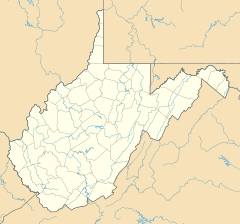Burning Springs, West Virginia facts for kids
Quick facts for kids
Burning Springs
|
|
|---|---|
| Country | United States |
| State | West Virginia |
| County | Wirt |
| Elevation | 643 ft (196 m) |
| Time zone | UTC-5 (Eastern (EST)) |
| • Summer (DST) | UTC-4 (EDT) |
| ZIP codes |
26139
|
| GNIS feature ID | 1549617 |
Burning Springs is a small, unincorporated community in Wirt County, West Virginia, United States. It got its unique name because of natural gas that would bubble up from a spring. This gas could actually be lit on fire!
Contents
History of Burning Springs
Burning Springs has a very interesting past, especially when it comes to oil. It was a key location in the early days of the oil industry in the United States.
Early Discoveries and Salt Production
In the early 1800s, people drilled wells at Burning Springs. They were looking for brine, which is very salty water. They would evaporate this brine to make salt. Along with the salt brine, they also found some petroleum, which is crude oil.
By 1836, these salt wells were producing a good amount of oil. They made about 50 to 100 barrels of oil each year. This oil was sold to be used as lamp oil. This means that Burning Springs was producing and selling oil many years before the famous Drake Oil Well in Titusville, Pennsylvania.
The Rathbone Family and the Oil Boom
In 1842, a man named John V. Rathbone bought 100 acres of land in the area. About ten years later, he drilled a new well. He discovered that this well produced much more oil than salt. By 1859, his well was producing seven 40-gallon barrels of oil every day. This was a much better way to get oil than just collecting it from the nearby river.
The first well drilled specifically for oil (not salt) at Burning Springs began in 1859. Soon after, the Rathbone family, including John V. and his son John C. ("Cass") Rathbone, sold 70 small plots of land. People bought these plots to drill their own oil wells.
In 1861, about 10,000 people moved to the area. The town grew very quickly and became a busy "boom town" that stretched for more than a mile. At this time, Burning Springs was even bigger than Elizabeth, which was the main town in Wirt County. It was also larger than Parkersburg. Oil barrels were transported down the Little Kanawha River to Parkersburg. From there, they were moved to larger boats on the Ohio River or loaded onto trains.
The Civil War and Its Impact
The American Civil War began around this time. Col. Cass Rathbone formed a group of local soldiers called a militia company. This group later became part of the 11th West Virginia Volunteer Infantry Regiment.
However, on September 2, 1862, Col. Rathbone and about 200 of his troops surrendered to Confederate raiders in Spencer, Virginia. The raiders immediately let Rathbone and his men go free. Some people thought this might have been a deal to protect the oil field from Confederate attacks. Rathbone was later dismissed from the army in January 1863.
On May 9, 1863, during a Confederate attack called the Jones-Imboden Raid, the raiders set fire to every oil well in Burning Springs. They also burned 120,000 gallons of oil that were ready to be shipped. This attack destroyed the town. The river and its forested banks burned for miles.
Rebuilding and Legacy
The Rathbones and others managed to rebuild some parts of the town. But in 1865, after John V. Rathbone died and several others passed away during the war, the remaining Rathbones sold their share for $400,000 and moved west. Other people continued to drill hundreds of wells in the decades that followed. Even though Burning Springs is a small town today, some oil production still continues.
The Burning Springs Complex was added to the National Register of Historic Places in 1971. Not many of the original buildings are left because fire was always a big danger for the wooden structures. The Ruble Church was also listed on the National Register of Historic Places in 1982. In addition to a historical marker that remembers the Rathbones, a park and museum were opened in 2002.
See also
 In Spanish: Burning Springs (Virginia Occidental) para niños
In Spanish: Burning Springs (Virginia Occidental) para niños



